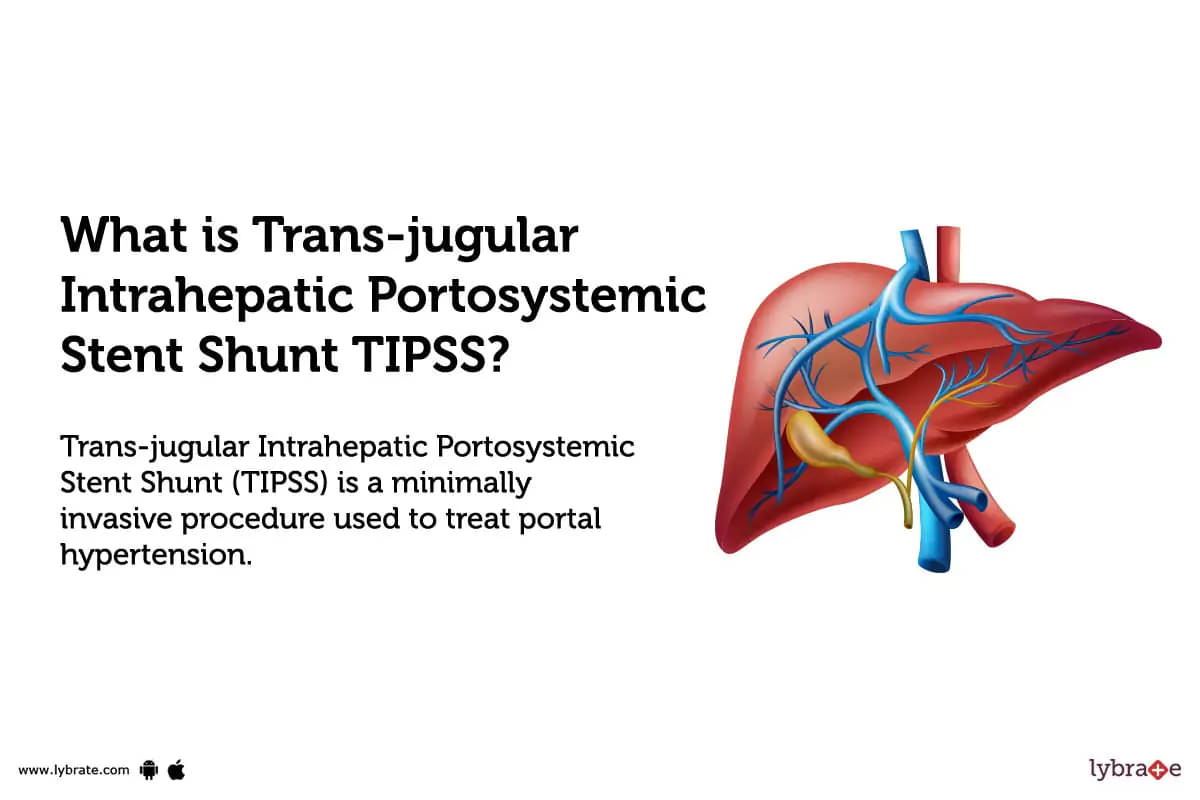Transjugular Intrahepatic Portosystemic Stent Shunt TIPSS: Causes, Symptoms, Treatment and Cost
Last Updated: Jul 04, 2023
What is Trans-jugular Intrahepatic Portosystemic Stent Shunt TIPSS?
Trans-jugular Intrahepatic Portosystemic Stent Shunt (TIPSS) is a minimally invasive procedure used to treat portal hypertension.
Portal hypertension occurs when the pressure in the portal vein, which transports blood from the intestines and spleen to the liver, becomes excessively high.
This can cause complications such as bleeding from varices in the oesophagus or stomach, ascites (fluid accumulation in the abdomen), and hepatic encephalopathy (confusion or coma due to liver failure).
Types of Trans-jugular Intrahepatic Portosystemic Stent Shunt TIPSS:
There are two types of TIPSS:
- Balloon-Expandable Stents: These stents are made of metal mesh and are inserted into the portal vein through a catheter. Once in place, they are expanded with a balloon to open up the narrowed or blocked area.
- Self-Expanding Stents: These stents are made of nitinol (a shape memory alloy) and come pre-loaded on a delivery system. They expand automatically when deployed inside the portal vein, eliminating the need for a balloon catheter.
Benefits of Trans-jugular Intrahepatic Portosystemic Stent Shunt TIPSS:
The benefits of TIPSS include:
- Reduced risk of bleeding: By creating an alternate route for blood flow, TIPSS reduces pressure in the portal vein and decreases the risk of bleeding from varices or other sources.
- Improved quality of life: Patients with severe cases of portal hypertension often experience debilitating symptoms such as abdominal swelling, fatigue, and loss of appetite.
- Reduced risk of complications: By reducing pressure in the portal vein, TIPSS can reduce complications associated with cirrhosis such as ascites (accumulation of fluid in abdomen), hepatic encephalopathy (confusion due to liver failure), and spontaneous bacterial peritonitis (infection due to accumulation of bacteria).
- Minimally invasive procedure: Unlike traditional surgical treatments for portal hypertension, TIPSS is minimally invasive and does not require an open incision or general anaesthesia.
Why is Trans-jugular Intrahepatic Portosystemic Stent Shunt TIPSS done?
TIPSS is done by inserting a stent (a tube-like device) through a catheter into the portal vein. The stent creates an alternative path for blood flow between the portal vein and another nearby vein, allowing for better circulation and relieving pressure on the portal vein.
This reduces or eliminates symptoms associated with portal hypertension, such as varices bleeding and ascites.
It can also help improve liver function by reducing congestion in the liver caused by high pressure in the portal vein.
In addition to treating symptoms of portal hypertension, TIPSS may also be used to prevent further complications from developing by reducing long-term exposure to elevated pressure levels in the portal vein.
What are the risks of Trans-jugular Intrahepatic Portosystemic Stent Shunt TIPSS?
- The most common risks associated with TIPSS include bleeding, infection, and blockage of the stent.
- Bleeding may occur during or after the procedure, necessitating additional treatment or surgery to stop.
- TIPSS is also associated with the risk of infection, which may necessitate the use of antibiotics to treat..
- Blockage of the stent is another potential risk that can occur due to scarring or narrowing of the vein where the stent was placed.
- Other possible risks include bile leakage from the liver, damage to surrounding organs, and death due to complications related to TIPSS.
How do I prepare for Trans-jugular Intrahepatic Portosystemic Stent Shunt TIPSS?
- Before undergoing the Trans-jugular Intrahepatic Portosystemic Stent Shunt (TIPSS) procedure, it is important to take certain steps to prepare.
- Your doctor will likely recommend that you stop taking any medications that can increase the risk of bleeding, such as aspirin or non-steroidal anti-inflammatory drugs (NSAIDs).
- You may also be asked to fast for 8 hours before the procedure and refrain from drinking alcohol for 24 hours.
- If you have diabetes, your doctor may request that you adjust your insulin dose prior to the procedure.
- You should also make arrangements for a ride home after the procedure because you will be unable to drive due to the sedation or anaesthesia used during TIPSS.
- It is also important that you inform your doctor about any allergies or medical conditions that may affect your ability to undergo TIPSS safely and effectively.
How is the Trans-jugular Intrahepatic Portosystemic Stent Shunt TIPSS done?
A stent is inserted through the jugular vein in the neck and into the hepatic vein in the liver.
The stent creates a direct connection between these two veins, which allows blood to bypass the blocked portal vein and reduce pressure in the liver.
Steps to perform Before the procedure
- Before the procedure, the patient should be properly hydrated.
- The patient should receive anticoagulants such as heparin or low molecular weight heparin to prevent clotting of the shunt.
- An ultrasound of the liver should be done to check the size and shape of the liver, and to identify any possible blockages in the portal vein or hepatic veins.
- A chest X-ray may be taken to check for any lung problems that could cause complications during or after the procedure.
- Blood tests should be done to measure clotting factors and other indicators of liver function and health such as bilirubin levels, albumin levels, and prothrombin time (PT).
- An electrocardiogram (ECG) may also be done to check for any heart problems that could cause complications during or after the procedure.
- A contrast dye may also be injected into a vein in order to get a better view on an X-ray or CT scan of the area where the shunt will be placed.
Steps to perform During the procedure
- The patient is placed in the supine position and an ultrasound is used to locate the hepatic veins and portal vein.
- A needle is then inserted through the right jugular vein and guided into the hepatic vein using ultrasound guidance.
- A sheath is then inserted over the needle, allowing a guidewire to be passed through it into the portal vein.
- A stent-graft is then inserted over the guidewire and advanced through the portal vein until it reaches its desired location in the liver.
- The stent-graft is then expanded, creating a shunt between the portal vein and hepatic veins to reduce pressure in the portal system and allow blood to flow more freely from the liver to other parts of the body.
- Once in place, additional imaging (such as CT or MRI) may be used to confirm proper placement of TIPSS before it is secured with metal clips or sutures at both ends of stent-grafts for stability purposes
- The procedure ends with removal of sheath and needle from jugular vein, followed by hemostasis (stopping any bleeding) if necessary
Steps of perform After the procedure
- Monitor the patient's vital signs and laboratory results closely.
- Monitor for signs of bleeding, including hematemesis and melena.
- Administer medications as prescribed to help prevent clotting or bleeding complications.
- Educate the patient about the importance of following up with their physician for regular follow-up visits, and to report any changes in their symptoms or condition promptly.
- Monitor for signs of hepatic encephalopathy such as confusion, disorientation, or changes in mental status, especially if ascites is present pre-procedure or post-procedure.
- Encourage adequate hydration and nutrition to reduce the risk of hepatic encephalopathy and other complications associated with TIPSS procedures.
How much does Trans-jugular Intrahepatic Portosystemic Stent Shunt TIPSS cost in India?
The cost of Trans-jugular Intrahepatic Portosystemic Stent Shunt (TIPSS) in India can vary depending on the hospital and the individual case.
Generally, the procedure costs around Rs. 1,00,000 to Rs. 2,50,000.
What to eat after Trans-jugular Intrahepatic Portosystemic Stent Shunt TIPSS?
In general, some of the best foods to eat after TIPSS include:
- Fruits and vegetables: They're high in vitamins, minerals, antioxidants, and fibre. When possible, choose fresh produce.
- Whole grains: Choose whole-grain breads and pastas instead of refined grains for added fibre and other nutrients.
- Lean proteins: Include lean proteins such as fish, poultry, beans, nuts, seeds, tofu, or eggs in your diet for essential amino acids that aid in healing.
- Low-fat dairy products: Dairy products contain calcium and vitamin D, which are important for bone health. When possible, choose low-fat options such as skim milk or Greek yoghurt.
- Healthy fats: Include healthy fats from sources like olive oil or avocados in moderation for essential fatty acids that aid in healing and provide energy for the body’s cells.
- Water: Staying hydrated is key to helping your body heal after surgery; aim to drink at least 8 glasses of water per day if you can tolerate it.
Is Trans-jugular Intrahepatic Portosystemic Stent Shunt TIPSS safe?
Overall, TIPSS is considered safe when performed by an experienced interventional radiologist or hepatologist.
The most common complication associated with TIPSS is hepatic encephalopathy, which can be prevented by carefully monitoring patients’ liver function after the procedure.
Other potential risks include bleeding, infection, and thrombosis of the stent.
These risks, however, are uncommon when proper precautions are taken both during and after the procedure.
Is Trans-jugular Intrahepatic Portosystemic Stent Shunt TIPSS painful?
TIPSS is generally not considered to be painful, as it requires only local anaesthetic and sedation.
However, some patients may experience mild discomfort during the procedure due to the insertion of the catheter into the liver.
Additionally, some patients may experience pain or discomfort after TIPSS due to swelling or bruising at the site of insertion.
It is important that patients discuss any pain or discomfort they experience with their doctor so that they can receive appropriate treatment.
How long does it take to recover from Trans-jugular Intrahepatic Portosystemic Stent Shunt TIPSS?
The recovery time for a Trans-jugular Intrahepatic Portosystemic Stent Shunt (TIPSS) procedure can vary greatly depending on the individual and their overall health.
It is generally advised to allow at least two weeks for rest and recovery following the procedure.
What are the side effects of Trans-jugular Intrahepatic Portosystemic Stent Shunt TIPSS?
The most common side effects of Trans-jugular Intrahepatic Portosystemic Stent Shunt (TIPSS) include bleeding, infection, abdominal pain, nausea and vomiting, and fever.
Other potential side effects include bile duct injury, portal vein thrombosis, hepatic encephalopathy, liver abscess formation or rupture of the stent.
There is also a risk of stent migration or occlusion. In rare cases, TIPSS may cause death due to complications such as hepatic failure or cardiac arrest.
Trans-jugular Intrahepatic Portosystemic Stent Shunt TIPSS Aftercare:
Patients should follow up with their doctor within one to two weeks after the procedure.
- During this time, they may need additional imaging tests or other scans to ensure that the stent is functioning properly.
- Patients should also be aware of any signs of infection or bleeding, such as fever, chills, abdominal pain, or blood in their urine or stool.
- In addition, patients should follow a low-sodium diet and limit fluid intake in order to prevent fluid buildup in their abdomen (ascites).
- They should also avoid activities that require them to lift heavy objects or strain themselves physically.
- Alcohol consumption should be avoided as it can increase pressure in the portal vein.
- Finally, patients should take medications as prescribed by their doctor and attend regular follow-up appointments for monitoring of their condition.
Conclusion:
Trans-jugular Intrahepatic Portosystemic Stent Shunt (TIPSS) is an effective procedure for treating portal hypertension and its complications. Cirrhosis, portal vein thrombosis, Budd-Chiari syndrome, and other conditions have all been successfully treated with it.
The procedure is minimally invasive and has a low complication rate. However, it does carry some risks such as hepatic encephalopathy, stent occlusion, and infection. Patients should be carefully monitored after the procedure to ensure that any potential complications are identified early and treated appropriately.
Table of content
15+ Years of Surgical Experience
All Insurances Accepted
EMI Facility Available at 0% Rate
Find Radiologist near me
Ask a free question
Get FREE multiple opinions from Doctors



